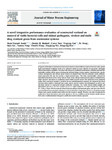A novel integrative performance evaluation of constructed wetland on removal of viable bacterial cells and related pathogenic, virulent and multidrug resistant genes from wastewater systems

View/
Date
2020-02Author
Donde, Oscar Omondi
Makindi, Stanley M
Tian, Cuicui
Tian, Yingying
Hong, Pei
Cai, Qijia
Yang, Tiantian
Wang, Chunbo
Wu, Xingqiang
Xiao, Bangding
Metadata
Show full item recordAbstract
Integrative performance evaluation of constructed wetland in removal different aspects of bacteria under specific
local environmental conditions needs to be explored in detail to ensure selection of appropriate and highly
efficient macrophytes candidates. To achieve this, integrative purification performance evaluation approach that
holistically considers all the aspects of pathogenic bacterial biology (colony numbers, functional gene, species,
virulent, pathogenicity and resistant genes) needs to be adopted rather than the commonly known unidimensional approaches that take into account a single bacterial aspect. This study experimentally evaluated the
individual performance of three native and one exotic winter tolerant submerged macrophytes combined with a
single emergent macrophyte in eradicating faecal related bacterial species and pathotypes across horizontal
surface flow constructed wetland. It involved the new multi-dimensional approach that integrated the faecal
bacterial colony numbers, functional gene copies, species survival, virulent and pathogenicity as well as antimicrobial resistant in constructed wetland purification evaluation. The results showed Elodea nuttallii and
Myriophyllum spicatum as the best candidate partners to Typha latifolia for the highest Purification Efficiency
(P < 0.05), of above 97% for removal of faecal bacteria colonies and functional genes, and more than 75% for
removal of faecal bacterial strains, pathotypes, virulent and well as resistant genes. However, M. spicatum being a
Chinese native species should be much preferred to the invasive E. nuttallii. Therefore, the study recommends the
application of local macrophytes such as M. spicatum as the best candidates and the decision should emanate
from such a multidimensional/intergrative purification-based evaluation approach.
